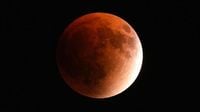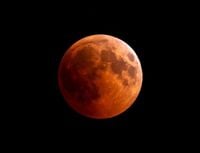On the evening of September 7, 2025, sky-watchers across the globe were treated to a dazzling celestial spectacle: a total lunar eclipse, popularly known as the "Blood Moon." This rare event, which painted the moon a deep, rusty red, was visible in its entirety across vast swathes of Asia, Africa, Australia, and the Middle East, captivating millions and leaving a trail of awe-struck faces in its wake.
According to BBC, the Blood Moon phenomenon occurs when the Moon passes directly through Earth's shadow, a process that transforms its usual silvery glow into a dramatic crimson hue. This transformation is the result of a fascinating interplay between sunlight and Earth's atmosphere. As the Moon moves into the planet's shadow, shorter wavelengths of light—like blue and violet—are filtered out, while longer red wavelengths are refracted and bent toward the lunar surface. The result? A moon that glows an eerie, beautiful red, inspiring both scientific curiosity and poetic wonder.
This particular eclipse was notable not just for its vivid color, but also for its global reach. Images circulated by Getty Images, AFP, and other agencies showed the Blood Moon rising above iconic skylines and landmarks: from the top of Shanghai's World Financial Centre and the promenades along the Huangpu River, to the beaches of Odesa in Ukraine, the minarets of Kuwait City, and the golden statues of Dresden, Germany. In Berlin, the moon loomed near modern buildings, while in Johannesburg, South Africa, it hovered above the clouds. Even in the hazy skies of Baghdad, near a Ferris wheel, and high above Egypt's Sinai desert, the Blood Moon commanded attention. In Jerusalem, it illuminated the night, and in the UK, it was spotted above Malton, albeit briefly as it rose.
In Israel, the lunar eclipse began at 7:27 PM local time, just 37 minutes after moonrise, as reported by Haaretz. The totality phase—the period when the moon is fully engulfed in Earth's shadow and appears most red—lasted for an hour and 22 minutes, from 8:30 PM to 9:52 PM, peaking at 9:12 PM. The entire event wrapped up at 11:55 PM, giving local sky-gazers ample time to marvel at the sight. Public viewing events were organized across the country, though some had to contend with patchy cloud cover.
But Israel was far from alone. The eclipse's path stretched across the Middle East, the Horn of Africa, eastward to the Philippines and Western Australia, and as far north as the Arctic and south to Antarctica. Sky at Night Magazine noted that the best places to catch the full spectacle were India, China, Russia, Australia, New Zealand, and regions in central Asia and east Africa. In the UK and parts of western Europe, only a glimpse of totality was possible as the moon rose, while North America missed out entirely—except perhaps for a sliver of partial eclipse in western Alaska.
For those who couldn't see the event in person, technology came to the rescue. Sky at Night Magazine pointed readers to a livestream hosted by Time and Date, ensuring that even those clouded out or on the wrong side of the globe could witness the Blood Moon's transformation. Enthusiasts were encouraged to share their photos and experiences, further connecting a global community of stargazers.
The eclipse's timing was meticulously tracked. According to Sky at Night Magazine, the penumbral phase—the subtle initial shadow—began at 3:28 PM UTC, with the partial eclipse starting at 4:27 PM UTC. Totality commenced at 5:30 PM UTC, reaching its maximum at 6:11 PM UTC, and concluding at 6:52 PM UTC. The partial eclipse ended at 7:56 PM UTC, followed by the end of the penumbral phase at 8:55 PM UTC. These precise timings allowed observers around the world to plan their evenings and maximize their chances of catching the show.
This September full moon also carried a special name: the "Corn Moon." As explained by Sky at Night Magazine, each month's full moon has a traditional nickname reflecting seasonal changes or agricultural milestones. The Corn Moon, for example, marks the period when corn is typically harvested. While the nickname doesn't affect the moon's appearance, this year's Corn Moon was unique in that it coincided with a total lunar eclipse, earning it the moniker "Corn Moon eclipse" in some circles.
The science behind the Blood Moon is as captivating as the visuals. A lunar eclipse occurs when the Sun, Earth, and Moon align in a straight line, with Earth in the middle. Sunlight, blocked by Earth, must pass through our planet's atmosphere before reaching the Moon. The atmosphere acts as a giant filter, scattering shorter wavelengths and allowing redder light to reach the Moon's surface. This process, called Rayleigh scattering, is the same reason sunsets and sunrises appear red on Earth. During a total lunar eclipse, the effect is magnified, turning the Moon into a glowing ember in the night sky.
Unlike solar eclipses, which require special eye protection, lunar eclipses are perfectly safe to observe with the naked eye. As Sky at Night Magazine reassured readers, "Observing a lunar eclipse can be done with the naked eye, as it's perfectly safe to do so." This accessibility, combined with the event's rarity and beauty, explains why so many people around the world made an effort to witness it.
This was the second total lunar eclipse of 2025. Earlier in the year, the best views were in the Americas, but this September event was truly global in its reach. According to Haaretz, the next total lunar eclipse won't occur until late 2028, making this a particularly special occasion for those who managed to catch it. For eclipse enthusiasts, there's a partial solar eclipse to look forward to later in September, though it will be visible only from New Zealand, Antarctica, and parts of Australia.
As the Blood Moon faded and the regular silvery glow returned, observers were left with memories—and, for many, stunning photographs—of a night when Earth's shadow turned the ordinary into the extraordinary. Whether viewed from the bustling streets of Shanghai, the quiet beaches of Odesa, or the deserts of Egypt, the 2025 Blood Moon served as a vivid reminder of our planet's place in the cosmos and the simple, universal joy of looking up.





